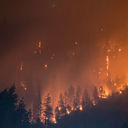
Services offered in the use of satellite data in decision-making
This offer is intended for stakeholders (public institutions, local authorities, companies, NGOs) who want to use satellite data in decision-making to facilitate the assessment, monitoring, and management of lands, natural resources (water, forest, soil, air, ecosystems, biodiversity) and global changes (pollution, scarcity, climate change).
Long-term planning that takes into account the contemporary challenges of sustainable development

Contemporary challenges (climate change, air, water, and soil quality issues, and biodiversity erosion) require rethinking the planning of urban and rural areas, adapting economic sectors, and better protecting our environment for future generations. The transition to more sustainable land management is necessary. The latter can only be effective if the planning is adapted to the global and local challenges with the objective to lead to better resilience and adaptation of the population and the ecosystems.
Satellite-based Earth observation data at the service of territorial planning
Earth-observation satellite data allow almost real-time monitoring of natural and anthropogenic phenomena in different times and locations on our planet. They thus make it possible to complete and densify the existing field data sets. Moreover, the physical and chemical properties of the terrestrial and marine environments such as temperature, soil moisture, water turbidity, water depth, vegetation index as a function of time can be extracted using modelling and processing tools.
The synoptic nature of the satellite-based Earth observations (spatial coverage and frequency of revisiting, etc.) enable to have value-added information in different locations from the global scale to the scale of the crop over a period ranging from a few years to several decades and frequency from hour to ones a year. There are thus many and varied applications from monitoring the atmosphere, ocean, and land such as the characterization of the impact of human activity on the environment (e.g., agriculture, urbanization), climate change (e.g., sea-level rise, coastal erosion, melting mountain snow, drought) and crisis management (e.g., flood, marine submersion, storm).
Detailed information on land use in the southern Palawan region of Indonesia. The maps resulting from the analysis of Spot-4 and -5 satellite images highlighting changes in agricultural practices. In particular, they reveal the expansion of palm oil cultivation in 2003 and 2010 as the cost of the surrounding native ecosystem.

Earth-observation satellite data make them powerful tools for decision-making for alerting and monitoring natural (ex., droughts, floods) and anthropogenic (pollutions) phenomena and supporting the transformation of land and natural resources management (e.g., mapping of wetlands, mapping of crops biophysical properties, evaluation of continental water stock, mapping of water quality) essential for decision-making.

Pleiades images before (left column) and after (right column) the passage of Hurricane Irma over Saint-Martin in 2017. These images enable us to characterize the material (infrastructure) and the ecosystem (vegetation) damages.
So, whether you are researchers, entrepreneurs, local authorities, or even individual users, the information from satellite data can support you in transforming your activity to be more resilient to current and incoming environmental issues and more respectful to our environment. A broad range of activities can benefit space innovation, including agriculture, energy, insurance, the environment, urban and regional planning, civil protection, and humanitarian aid. Find some examples below:

ENVIRONMENT AND NATURAL RESOURCES
Airborne and Earth-observation satellite data enable to monitor the water resource from source to sea, including mountains, rivers, lakes, and wetlands (e.g., soil moisture, water height, suspended matter), to observe forests (e.g., vegetation index), and to control coastal areas (e.g., cliff erosion and coastline retreat).

AGRICULTURE
Airborne and Earth-observation satellite data allow a regular assessment of cultivated land (e.g., crop nature and extent, vegetation index, soil moisture) to estimate the crop productivity and water requirement.

POPULATIONS PROTECTION AND HUMANITARIAN RESPONSES
Airborne and Earth-observation satellite data participate in the implementation of precise warning systems required to alert local authorities and the population about a future or an ongoing disaster. It consists of providing precise geographical information of impacted areas and monitoring the condition of essential infrastructures such as clean water and sanitation services to facilitate responses.
My mission: To guide you in decision-making using innovative tools from satellite-based data
Graduated in environmental policy, Ph.D. in Earth sciences, and expert in the acquisition, processing, and analysis of remote sensing satellite data, my expertise in science, policy, and communication on sustainable development, space data, and the environment will allow me to provide you with expertise in order:
01
To better predict the consequences of climate change on natural resources and populations by participating in a better diagnosis of the regional and local impacts of climate change and by facilitating the sharing and dissemination of scientific knowledge to the stakeholders concerned and to the general public
02
To sustainably and efficiently manage natural resources (soil, water, forest, biodiversity) by taking into account environmental and climatic issues to adapt land use planning accordingly while taking into account the ecological continuity of terrestrial and aquatic environments
03
To better assess, monitor, and anticipate climatic and environmental (flood, submersion, landslide, hurricanes, storms, etc.) and anthropogenic (soil, water, and air pollutions) risks to reduce vulnerability and increase the populations and ecosystems resilience
Methodology
Define
with you your needs based on environmental and climatic challenges and your activities
Propose
in terms of an adapted methodology with recommendations of decision support tools based on satellite data adapted to your activities
Connect
with stakeholders from space community such as space data providers and services developers, and experts
Support
in grants proposal writing in the framework of projects based on the use of the space data (monitoring calls for projects, technical support for drafting requests, search for partners, etc.)
Assist
in the implementation of space data-based tools and services and their use in your activities








